China’s opaque Caribbean trail: Dreams, deals and debt
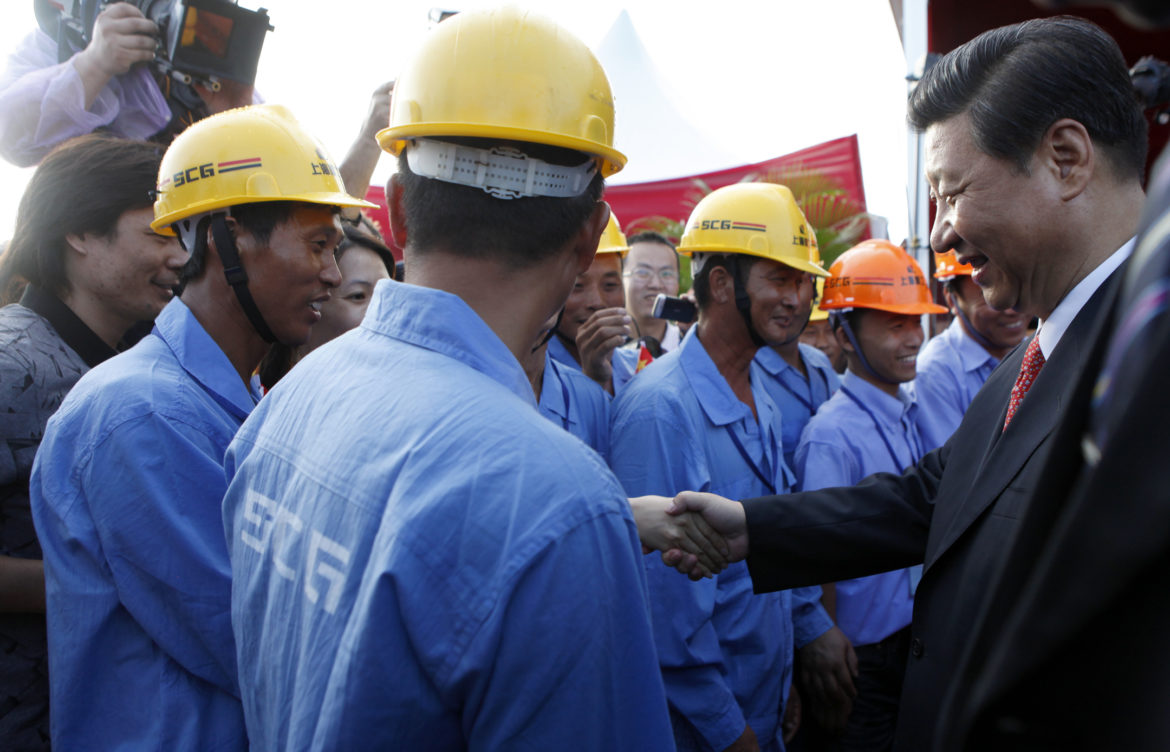
By CARLA BRIDGLAL, IVAN CAIRO, STEFFON CAMPBELL, ALIX LEWIS and NEIL MARKS From CIJN
A hotel. A highway. A port. The prime minister’s house. For Caribbean countries, one of the most visible, expansive, and expensive forms of Beijing’s engagement with the region is its financing of large-scale infrastructure projects.
China’s growing economic presence in the Caribbean is readily associated with such undertakings, but an MIC investigation into the conduct of business with the Asian powerhouse in the region has unveiled a trail of official secrecy, questionable procurement processes, and the looming threat of potentially insurmountable debt.
Economies weakened by mixed internal and exogenous economic conditions, retreating economic support from traditional multinational agencies, an appetite for high-profile “dream” projects, and offers of soft repayment terms have all conspired to create entry points for a wider and deeper Chinese presence in the Caribbean.
Standing on a political platform in June 2018, just one month after Trinidad and Tobago became the first country in the Caribbean to officially sign on to China’s $4 trillion global development strategy, the Belt and Road Initiative (BRI), the country’s Prime Minister Dr Keith Rowley described the new dynamic:
“We told them we need your investment and you need our location in the Caribbean,” Dr Rowley said.
As the world economy evolves, he continues, so too must T&T: “Foreign investment came to this country from Britain and later from the United States, and all along we’ve had this foreign investment inflow. But today China is the world’s second-largest economy so while the economy of Britain drove us for a while and the US for another period, if we are to tap into serious inflows of foreign direct investment we have to look into countries that are looking for investment opportunities abroad and China is that today.”
Suriname signed on in June that year, and in August, Guyana’s then Foreign Minister Carl Greenidge and China’s ambassador to that country, Cui Jianchun, signed the agreement that officially drafted Guyana into the BRI.
Jamaica, the second biggest economy in the Caribbean, was relatively late to the game, finally signing on to the BRI in April 2019. Be that as it may, of the Caribbean Community’s (CARICOM’s) 15 member states, five have diplomatic relations with Taiwan.
Increased bilateral trade and access to China’s vast and growing economy have been the ostensible reasons for the Caribbean’s ready acceptance of the nearly $50 billion China has made available to the region for infrastructural development.
From 2005-2018, Chinese banks (China Development Bank and China Export-Import Bank) were the largest lenders in Latin America and the Caribbean. Accumulated loans have surpassed $140 billion. Of that, Trinidad and Tobago accessed $2.6 billion and Jamaica, $2.1 billion.
Over the last 25 years, China has put an estimated $8.25 billion in the Caribbean and upcoming projects could add another $8.92 billion.
Over the past 10 years, project values have increased by 800 per cent. Most of this money comes in the form of concessional, government-to-government loans with interest rates well below market levels (some as low as two per cent) making them attractive to highly indebted, economically challenged Caribbean countries.
The Caribbean Development Bank estimates the region would need about $30 billion to modernise its infrastructure over the next decade. With global development assistance from traditional partners drying up, Caribbean countries have readily grasped Beijing’s offer of easy financing.
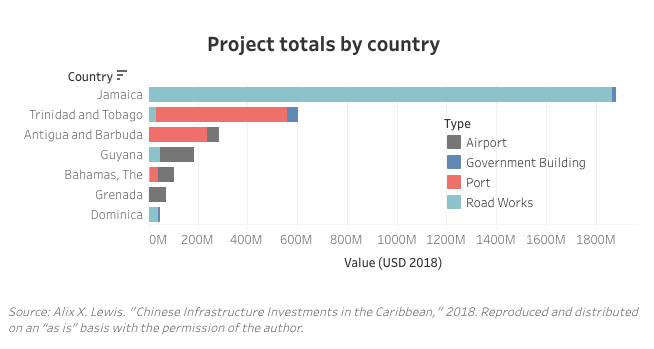

The short term benefit is obvious – a region with critically outdated infrastructure finally has the opportunity to get much needed investment to transform and grow its means of production.
The MIC investigating team however found that in most instances, negotiations for these government-to-government projects and the precise terms of the agreements are not routinely publicised, leading to concerns about procurement processes and concessions related to local content, labour practices and adherence to building and other codes.
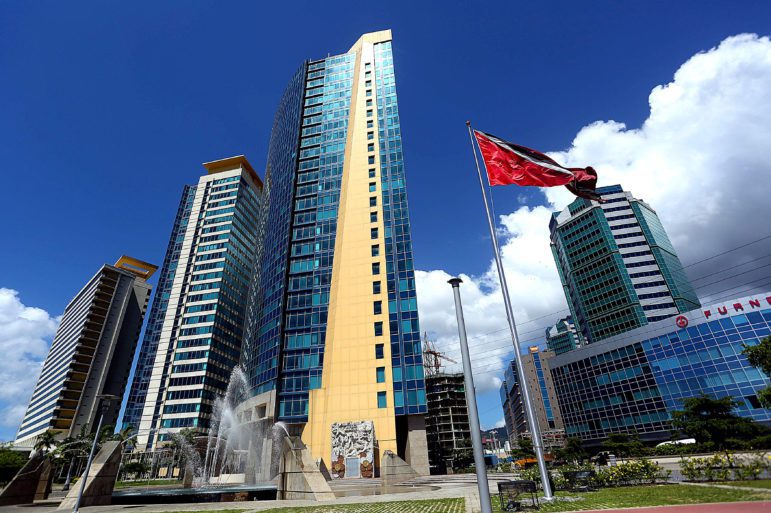

Looks Good on Paper
China’s Caribbean portfolio is extensive. It includes highways and bridges, housing, energy, mining, air and sea ports, tourism projects, hospitals, and even official residences, forming a part of that country’s strategic thrust into Latin American and the Caribbean.
Proposed projects could offer China a strong trading foothold among tens of millions in Brazil’s landlocked south via hundreds of miles of paved road through Guyana’s jungle and then off to the Caribbean Sea to a docking port in Trinidad originally intended to service ships passing through the Panama Canal.
But the Caribbean’s thirst for financing and Beijing’s style of conducting business have offered up some interesting dynamics.
Legal disputes associated with the $3.5 billion Baha Mar resort project – the work of China Construction America, a subsidiary of China State Construction Engineering – in The Bahamas led to a downgrading of the country’s S&P Global rating in 2015.
In Jamaica, a 2012 independent forensic audit of the Jamaica Development Infrastructure Programme (JDIP) and the Palisadoes Shoreline Protection and Rehabilitation Works Project concluded there was “non-adherence to allocations approved by Parliament and the Ministry of Finance. There was also the arbitrary issuance of Variation Orders and selection of sub-contractors along with unprogrammed and arbitrary allocation of funds for institutional strengthening,” according to the audit document.
In Trinidad and Tobago, the sudden termination of the Government’s $71.7 million project between China Gezhouba Group International Engineering Company and the Housing Development Corporation (HDC) in 2019 has drawn attention to a lack of transparency in the award of the contract, and what has been described as overly generous concessions to the Chinese company.
In Guyana, a $150 million project to upgrade the Cheddi Jagan International Airport remains incomplete more than 10 years after it began – seven years behind schedule and counting – due to various concerns over workmanship and other technical issues.
And, in Suriname, there are fears that mounting debt to China, spanning decades, can have the impact of stalling future development and exposing the country to liabilities way in excess of its ability to pay.
The China Export-Import Bank (China EXIM), principally, and the China Development Bank (CDB) – two Chinese state-owned banks – have been responsible for a large proportion of Chinese concessional loans in support of Caribbean projects.
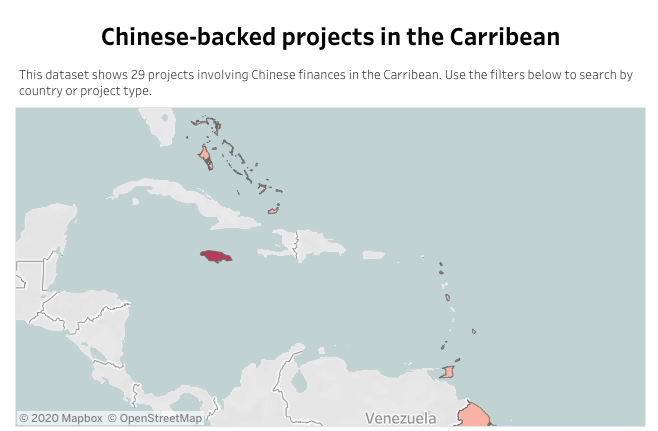

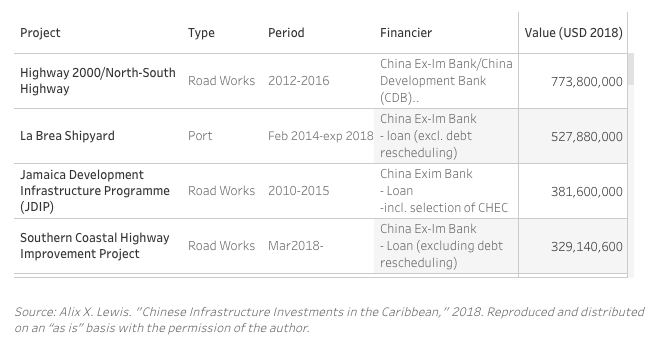

The banks administer such foreign aid loans using subsidies from China’s foreign aid budget in order to soften lending terms.
Soft Diplomacy, Hard Consequences
Caribbean governments however resist the notion that Chinese funding is an avenue for Chinese hegemony in the region.
Just after Guyana signed on to the BRI, President David Granger shut down suggestions of a potential debt trap, insisting Guyana had signed on with its “eyes wide open.”
If Chinese funding is available, he insisted, it will be sought. “Our longest river is one thousand kilometres long – the Essequibo – but there is not a single bridge,” President Granger told journalists. “We have to build a bridge. We (also) have to build a railway or a road link to the Rupununi which is our largest region.”
Guyana is on the cusp of a life-altering economic transformation, with its first commercial oil production carded for 2020. The International Monetary Fund’s World Economic Outlook for October 2019 projects the Guyanese economy will grow over 85 per cent in the next year. Until then, the South American country is still strapped for cash to devote to infrastructure.
“We cannot develop without infrastructure and we just do not have the capital to do it on our own. So, whether it comes from America, China or Britain we have to have it, and of course we have to look for the best deal,” Granger said.
The United States has however warned that countries of the region be cautious about China’s relatively recent bullishness on new investments. Ahead of a visit to the region in February 2018, then then U.S. Secretary of State Rex Tillerson said China had been using “economic statecraft to pull the region into its orbit.” The question, he went on to ask, was “at what price?”
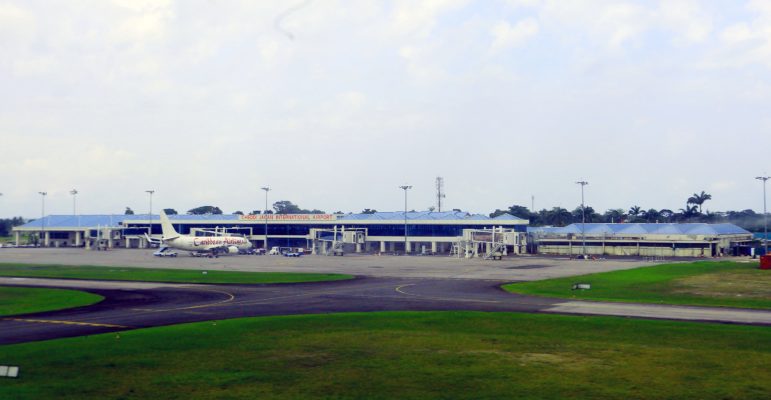

An April 2019 report to the US Congress titled “China’s Engagement with Latin America and the Caribbean” notes that US lawmakers, traditionally the region’s hegemonic power, have raised questions about China’s increased engagement with the region over the last 20 years, particularly economic and diplomatic ties, which reflects China’s growing “soft power” efforts worldwide.
China’s economic engagement could have potential harmful effects, especially those who have amassed unsustainable levels of debt to China, leaving those economies at risk of becoming less competitive in manufacturing and agricultural technologies and more dependent upon commodities exports to China and elsewhere. There is also the concern that Chinese support extends a lifeline to leaders with poor records of governance and can exacerbate corruption.
The devil is always in the details, and, as Dr Evan Ellis, a research professor of Latin American studies at the Strategic Studies Institute of the US Army War College who focuses on the region’s relationship with China, points out, the Chinese are skilled negotiators and if partners aren’t paying attention there’s plenty chance of things going awry.
China’s engagement in the region isn’t necessarily negative but it is a difficult sort of relationship one has to go into with strong governance and a lot of transparency and good planning to get the best deal, he said.
“If you have a project for which you might not have a good business plan, when you do negotiations (if) you are not paying attention to the fine points (and) get the money without a viable plan (it) sets the recipe for disaster because at the end of the day if it doesn’t work out the country is in debt and loses even though the Chinese company wins.”
While that’s not to say these projects are bad, there are some red flags, he said, because of how easy the Chinese make it to access these loans.
“Traditional multilateral institutions like the IMF or World Bank force you to show you have a business plan and credible model as well as environmental compliance, etc. The Chinese, if they can assure they can get repaid in one way or another they don’t necessarily need to satisfy themselves that the investment itself makes sense.”
Dealmakers That Should have been Deal-Breakers
During the course of this investigation, the MIC team examined contracts that, in some cases, were only made public through leaks or freedom of information requests, paying special attention to waivers, arbitration and concessions. In many cases, some governments have withheld contracts and agreements from the public. And, in the case of Trinidad and Tobago, senior government ministers spanning different political administrations even confessed to not having viewed final documentation despite giving their approval in Cabinet.
Waivers
Waivers of some rights have been found to be standard fare in contracts of the magnitude China has signed with the Caribbean.
In the case of Jamaica, for the $630 million North-South Highway project signed with China Harbour Engineering Corporation (CHEC) on June 21, 2012, the government exposed itself to significant debt. According to clause 13.3 of the contract,
“The Government shall unconditionally and irrevocably waive any right of immunity (to the fullest extent permitted by applicable law) which it or any of its assets now has or may acquire in the future in any jurisdiction.”
This risk is something Prof Craig Clarke, lecturer in the Department of Government at the University of the West Indies, finds hard to grapple with.
The clause speaks specifically to the implication of a possible breach of contract on the part of the Government of Jamaica or such cases where actions of the Jamaica government result in losses to the CHEC, he told MIC.
“When contextualised, the clause – which requires that the GOJ forfeit any asset currently owned or assets owned in the future – could prove instrumental in debt recovery by asset seizure,” Craig said.
However, it is not the just debt recovery that bothers Clarke. The clause essentially makes all publicly-owned assets in Jamaica accessible to seizure.
“This means the national water infrastructure, for example, could be claimed as part of the repayment mechanism. And that is a very scary thought.”
The onus then, Clarke posits, is on the Government of Jamaica to “ensure that there is no circumstance where this clause become actionable.”
Similarly, the $46.7 million contract, funded by the Eximbank for a road improvement project in Guyana, signed on January 9, 2017, says in Article 8.1:
“The borrower hereby irrevocably waives any immunity on the grounds of sovereignty or otherwise for itself or its property in connection with any arbitration proceeding…or with the enforcement of any arbitral award pursuant thereto.”
Guyanese attorney Shivanie Lalaram said sovereign immunity is a state’s freedom from being subject to the legislative, judicial and administrative powers of another state.
“In waiving its immunity, Guyana is submitting itself to the jurisdiction of China. Therefore, the municipal laws of Guyana that would have related to the Agreement would not apply,” Lalaram explained.
Sydney Armstrong, head of the Department of Economics at the University of Guyana, sees this clause and others in the contract as putting countries at significant risk in the event of late payments or a lack of payment for whatever reason.
“The seriousness of this clause is underscored by the fact that these roads (as in Guyana’s case) and ports are often times critical for the proper functioning of the economy and if controlled by a foreign entity can hinder the economic progress of the nation. This is extremely worrying,” Armstrong said.
Attorney and chartered accountant Christopher Ram describes Article 8.1 as being “the essence of the Sri Lankan experience” whereby China could take control of Guyana’s assets. Sri Lanka is frequently referred to as an example of China’s global “debt trap” after that country’s inability to repay its debt $1.12 billion debt allowed China to negotiate 99-year lease arrangement for its Hambantota port, strategically located on the Indian Ocean, as an exchange.
“(This) is Guyana dangerously agreeing to cede sovereignty. It plays into the Chinese strategy of using economic weaponry in the pursuit of influence and domination,” Ram said.
In Jamaica’s case, there are other clauses in the North-South Highway project that have raised other alarms, such as those that could strangle similar road infrastructure projects.
“Clauses 9.3 (a) and (b) are quite problematic, in so far as they prevent the central government, local governments or any agency under the auspices of the (Government of Jamaica) from making any alterations or improvements to ‘alternative or competing roads’ to the highway,” says Clarke.
There are no avenues for road expansion or improvement in such areas like Ewarton or Chalky Hill, even if such improvements would increase the speed of journey or capacity (meaning number of lanes) to the benefit of Jamaicans.
The government will not be able to build new railway transport systems or change the route of existing railway systems nor can it introduce a ferry from the parish of St Catherine to the tourism hub of Ohio Rios if it is deemed in competition with the highway.
“These clauses are very restrictive and the people who live along this Transport Corridor will be mostly affected, because these clauses limit the kinds of alterations the (Government of Jamaica) can make,” Clarke argued.
Costing is also a concern. When CHEC offered to do the project, it carried out its own traffic forecast, which came out higher than that of the global consultancy Steer Davies Greave, hired by Jamaica’s National Road Operating and Constructing Company (NROCC).
“The Chinese got the numbers to work – somehow,” Ivan Anderson, NROCC managing director said in a case study conducted by the Caribbean Development Bank (CDB).
The NROCC advised that there was no way costs could be recouped through toll payments. CHEC had an answer: land adjacent to the highway could be given to them to develop commercial activities. Jamaica agreed and signed the project. The Chinese company promptly brought in 1,000 Chinese workers to get the job done.


Arbitration
In the case of the Guyana East Coast Demerara Highway Project, at Article 8.4, Guyana has expressly agreed to be subject to the laws of China, which may include the Financing Laws of China.
“Therefore, if dispute arises pursuant to the agreement, these disputes will be determined by the Laws of China as applicable to the agreement,” says Lalaram.
Article 8.5 stipulates that in the event of arbitration, parties have to submit their dispute to China International Economic and Trade Arbitration Commission (CIETAC) and the arbitration process will be govern by Chinese laws and the hearing be held in Beijing.
“This here goes against the fundamental principles of arbitration,” Armstrong said. For arbitration to work, he argues, it should be conducted by a neutral party.
“Sorry, I don’t see CIETAC – a Chinese commission – being neutral in a Chinese dispute,” he concluded.
Arbitration, Armstrong says, should also be conducted in a neutral territory to avoid any bullying or bias.
“I can assure you that small states or representative from small countries (and this includes Guyana) will feel restraint when it comes to expressing themselves in relation to the dispute.
“I don’t think the proceeding, under these circumstances, will be done in good faith,” he said.
There is some precedent in the Caribbean to warrant this skepticism: when the Baha Mar project, a $3.5 billion resort touted as the biggest in the Caribbean, went into bankruptcy proceedings, the contract stipulated resolution in Hong Kong, putting Swiss-born developer Sarkis Izmirlian, who had conceptualised the project at a disadvantage, eventually losing his over $800 million investment. The project was eventually sold to Chow Tai Fook Enterprises Ltd, a Hong Kong conglomerate with significant real estate holdings and ties to Beijing.
Regional governments and China, meanwhile, reject any suggestions that the terms of the contracts or the financing terms could lead to seizure of assets by China.
“China doesn’t have this culture of taking over others’ things,” Zhang Jinxiong, a former Chinese ambassador to Suriname told MIC.
“In connection with the question of taking-over, I would like to add (that) the Chinese never think of that and we don’t do that.”
China is now the lead development partner for Suriname. According to Zhang, there should be even more Chinese investments in Suriname.
“Actually, we should encourage more investments from China in Suriname. When you look at the development here in the past 20 years, you have more and better roads, better quality of life. That is good for Suriname. So, why are Surinamers so afraid of that?”
Under the Jules Wijdenbosch administration in the late 1990s, Chinese funding brought in Dalian International firm for a package of road projects. It later emerged that Dalian had employed false corporate documents in order to seal the deal.
The contract was modified after Parliamentary scrutiny but Dalian kept on getting contracts for asphalting projects in Suriname. It has recently been contracted to execute a number of public housing projects.
Beyond Dalian, a number of new Chinese companies have been retained to carry out infrastructure projects in Suriname. But the details of the contracts remain a secret.
When questioned on the possibility of a Chinese debt trap, Suriname’s Foreign Minister Yldiz Pollack-Beighle, said she would not be dragged into the question of “what if.”
“Since Suriname has the principle of non-interference in the internal affairs of sovereign states, no statement can be made regarding what’s happening in other countries,” she said.
The minister asserted that for Suriname to achieve or guarantee sustainable economic growth and stability, it has to enter into partnerships.
Since the Bouterse administration came into office in 2010, financial cooperation between
Suriname and China has accelerated to a large extent because The Netherlands has essentially withdrawn developmental aid, preferring not to have relations with Bouterse, who has been convicted and sentenced, in absentia, on charges of drug trafficking.
China appears to have willingly filled the void and has provided various concessional loans and donations to Suriname over the past nine years. But most of the details of the deals cut between Chinese companies and the government remain tightly-guarded secrets. Typically, loan amounts, grace periods, interest rates and the duration of projects are the only information publicly released.
For those to whom the contracts are ostensibly available – government ministers and senior state officials – few claim to have read them.
“The contracts were available, but the general practice was that not many cabinet ministers were interested to read those pile of documents, especially if it didn’t regard your ministry or portfolio,” says Michael Miskin, former minister of Trade and Industry.
In Trinidad and Tobago, among the basket of trade deal goodies negotiated by the government and China during that official visit last year was a $500 million dry-docking facility in the village of La Brea, an industrial park in Phoenix Park, Point Lisas and a housing project with the state-owned Housing Development Company.
Desperate to create new opportunities, especially in the southern half of the island following the closure of the 101-year-old Pointe-a-Pierre oil refinery, the government insists that Trinidad and Tobago is getting the best possible deal.
“We are different to Sri Lanka,” Prime Minister Dr Keith Rowley told reporters in defence of such a possibility regarding the La Brea Industrial Park project. China Harbour Engineering, the contractor, will have a 30 per cent stake.
The details of the project are not yet available, though the project could start before the end of the year. “We wanted an equity partner to share the cost and the risk of making the business succeed,” Dr Rowley said.
Many hauler ships are Chinese, so if the Chinese Government has a 30 per cent stake in the La Brea Dry Dock they will also have a vested interest in sending such vessels to TT for servicing, Rowley stated. The government insists that the country’s debt profile is manageable.
“I understand with the closure of Petrotrin there’s a need for employment but the question is if you are a shipping company I’m not sure research has been done (about La Brea’s viability). It’s a relatively expensive port in terms of pay rates that’s basically in the middle of your transit. It’s not a place where a shipping line would naturally do repairs,” Ellis said.
With the Phoenix Park industrial project, he notes that his understanding is the government spends something like a billion dollars in local currency for a project that is 40 per cent done by a Chinese contractor with the general promise that maybe 60 companies will set up. The government has insisted there are ten Chinese tech firms already lined up as guaranteed tenants. “But the question,” Ellis said, “is if there a contractual stipulation that the Chinese companies will actually come out or is it just a general hope and will the TT government therefore find itself pressured to offer special labour zones or other concessions?”
“At the end of the day for me a lot of projects work out like this. When you don’t do it with enough attention to legal details or planning and it’s too easy to get the money you can commit public funds in a way that can prejudice the country and benefit the Chinese company.”
The projects are already off to a late start, despite continued assurances and several memoranda of agreements signed. For the Phoenix Park Industrial Estate, which was initially scheduled to start last December, the governments of Trinidad & Tobago and China only on November 13 signed another MoA, this time for a “framework agreement” for a concessional $15.4 million loan for the project.
But despite the grandeur of a signing ceremony, key details were still vague. Asked specifically on what the time frame for repayment, interest rate, and terms and conditions of the loan were, Trade Minister Paula Gopee-Scoon told the TT Newsday, “That is still (a matter) for the Ministry of Finance in their negotiations with the China Exim Bank.”
She added: “It’s a concessional loan, so I’m sure it’s at a very low interest rate, but it is a matter for the Ministry of Finance in their negotiations.”
The recent Summary Economic Indicator bulletin from the Central Bank puts Trinidad’s total public sector debt for 2018 at $18 billion or 60.7 per cent of GDP; of that, $325 million is owed to China, the government disclosed last year.
With the new projects in the pipeline, that estimate is now reportedly over $890 million. Among the projects Trinidad still owes China for funding include nearly $91.5 million for the National Academy for the Performing Arts (NAPA) in the capital, Port of Spain, and its southern sister, NAPA’s South Campus as well as nearly $147.6 million for the Couva Hospital, located in central Trinidad.
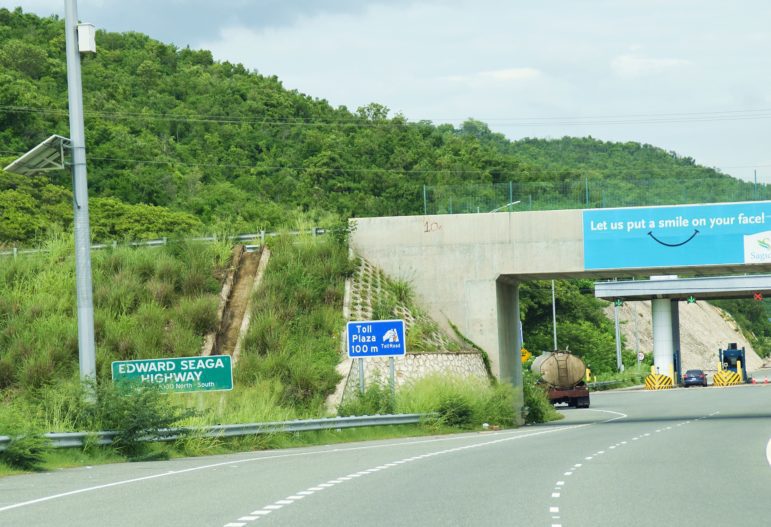

Concessions
The Cheddi Jagan International Airport project in Guyana is sometimes cited in some circles as an example of how the Chinese have been able to negotiate what appear to be heavily one-sided deals. The contract for the project, for which China provided a $130 million loan, raised eyebrows from the beginning.
“The decision on the airport was announced in Jamaica while Guyanese were kept in the dark,” says Ram, who has been a regular commentator on the quality of the contract. His advocacy, together with rising public concern led the David Granger administration to eventually release the details of the agreement.
“The airport project was more supply driven by the Chinese than demand driven by Guyana and it appeared at the time that it was undertaken because the Chinese said the money was available. It was decision first and justification after,” Ram argued.
What was very unusual for the lump sum contract was that it came with a 33-page Bill of Quantities, providing “provisional” figures for items such as toilet sets which were billed at almost $2,500.
The contract was signed just before the November 2001 general elections and the feasibility study done six months after the deal was sealed.
The agreement was for CHEC to be paid the full contract price and be freed from paying any taxes, duties, royalties and fees imposed by the central or any local government and statutory authority. CHEC was also permitted to bring in 60 percent of Chinese labour for non-technical work and hire only Chinese for technical work.
The government agreed to secure all the necessary permits, licences or approvals from relevant authorities, including vessels, cars and vehicles, GPS frequency, mobile phone, internet, materials, equipment, tools, and medicines, without fees and free of taxes.
The government also agreed to construct, for free, a car park, internal roads and handling equipment area.
The government was also required to design and construct a new cargo area and fuel area.
Incredibly, the government agreed to provide the sand and other fill material to the contractor for free and if not delivered in the quantities and time required, CHEC could then bill the government for expense and buy more time.
Further, it was the government’s job to remove the old terminal building and cargo and fuel areas – and to do so as CHEC requires.
The loan was approved in Chinese currency with all the exchange risks borne by Guyana, driving up the contract cost if the renminbi appreciated relative to the Guyana dollar.
Guyana agreed that CHEC would pay no income or withholding taxes apply to any payment under the agreement, whether interest, management fee or commitment fee.
“The China policy, or non-policy, was more than just the Airport project – it also involved concessions and privileges governing our resources, the absence of a bilateral treaty, movement of nationals, taxation and repatriation of capital and interest,” states Ram.
The pattern throughout the region, then, was of disproportionate arrangements executed in an environment of state secrecy.
“I do believe that going forward, our Government needs to be extra careful in relation to the contracts it signs especially with the Chinese, be it for infrastructural development or any other aspect matter of fact. I don’t believe we read the fine print carefully and our track record speaks volume to this,” Armstrong said.
The more things change …
In Trinidad and Tobago, via a freedom of information request, the Joint Consultative Council for the Construction Sector was granted a copy of the contract that the HDC had made with the China Gezhouba Group International Engineering Company Ltd.
First reported by local newspaper the Trinidad Express, among the concessions were that the HDC agreed to “use its best efforts” to convert 60 per cent of the TT$485 million contract price to US dollars (despite chronic difficulty for members of the public to access foreign exchange). The HDC would also reimburse all of CGGC’s VAT payables one month after each interim payment certificate as well as all its corporate tax payments within a period of one month after the submission date.
The contract also ensures that the Chinese contractor does not pay customs duty or import duties, and all other related fees or charges levied on the contractor during the performance of the project, in accordance with the laws of T&T. In the event that the exemption is not approved by any authorities, all above-noted taxes, duties, fees and charges shall be reimbursed by the HDC through its own fund resources.
The state housing company was also responsible for obtaining all permits, including work permits for up to 600 Chinese workers, as well as provide land for temporary housing and security for the project site. The HDC was also obligated to pay 100 per cent of the contract price within 28 days of signing the contract, and any delays would incur a charge four per cent over the Central Bank’s discount rate.
After the terms of the deal were reported, the government quickly sought to quash it. In a post-Cabinet briefing PM Rowley said it was cancelled.
“That contract was reviewed extensively by the Cabinet and it has been stopped. HDC has been instructed to go back out to tender because there were some parts of that contract that did not meet Cabinet’s acceptance and approval, both structurally and legally. That contract has been stopped,” he said.
The HDC, for its part, maintained no discrepancy. Even as it accepted the Cabinet’s decision, the company said in a statement: “The costs and other associated matters related to the contract were determined after a year of negotiations between both organisations. This contract was executed legally and was conducted with the authority of the board, who acted within their remit.”
Rowley’s declaration was hailed by civil society as proactive in defence of the public purse.
But just a few days later, Attorney General Faris Al-Rawi suggested that the fuss over the project was “a storm in a teacup, nothing to lose sleep over.”
Al-Rawi, the MP for San Fernando West, a marginal constituency where about 235 of those affordable housing apartments were to be constructed, was unbothered. He told reporters outside of the Parliament a few days after the PM’s announcement, “I have been told that the project is on track… that is what I am interested in.”


About Carla Bridglal
Carla Bridglal is a Trinidadian journalist with a keen interest in human rights and an advocate for press freedom. As the Associate Business Editor at the Trinidad & Tobago Newsday, she has written extensively on macroeconomic policy, politics, and international relations, including Venezuela’s refugee crisis and China’s expansion into the Caribbean. Carla earned her MA in Journalism from Columbia University, specializing in business and economic writing. She is an inaugural fellow of the Media Institute of the Caribbean.


About Ivan Cairo
As a journalist he travelled extensively throughout the Caribbean and South-America, French-Guiana, USA, Mexico, Taiwan and China covering mostly political issues including various Summits of the Americas, Caricom Summits, UN Climate Summit and other events. He also reports on a regular basis on crime issues including drug trafficking, money laundering and human rights. He is a former president of the Surinamese Association of Journalists and attended numerous journalism training workshops and events in Suriname, the Caribbean and the USA and did a course in Financial and Business News Reporting at Reuters in London in 2012. He is also one of the founding fathers of the Association of Caribbean Media Workers. Ivan Cairo joined ‘de Ware Tijd’ newspaper in February 2002 and he is also a correspondent for several regional magazines, newspapers and news agencies in Guyana, Barbados and St. Vincent & the Grenadines. In August 2014 he won the Journalism Award 2014 and published his first novel, ‘Fatale Zonden’, in November 2014. In 2018 he won the Award for Journalism organized by the Center for Communications and Public Relations


About Steffon Campbell
Steffon R. K. Campbell is a published Trinbagonian author, Communication Consultant, Lecturer and Coordinator of the CARIMAC Western Jamaica Programme in Montego Bay. He holds a BA in Media & Communication (with first class honours), an MA in Communication Studies and is currently pursuing a PhD in Social Policy and a Bachelor of Law (LLB). He has been a regular contributor to the Western Mirror and has produced several radio programmes and documentaries, in Jamaica, St. Vincent & the Grenadines and Trinidad & Tobago. Steffon is currently on the Board of Directors for Universal Media Company Limited, which overseas NewsTalk 93FM and has worked with public, private and NGOs including the United Nations, Public Media Alliance (UK), AM Resorts, Sandals Resorts International and Jamaica AIDS Support for Life (JASL). Steffon R. K. Campbell lives by the motto: It’s not what you do…It’s what you get done.


About Alix Lewis
Alix Lewis hails from Trinidad and Tobago, and is a China-Caribbean specialist. Her research focuses on Chinese infrastructure investments in the Caribbean (1990-2018) in the English-speaking Caribbean. She holds a Master of Law in China Studies with a concentration in Politics and International Relations from Peking University, and a Bachelors of Arts in Economics with a minor in Chinese Language and Culture from Wellesley College in the USA.


About Neil Marks
Neil Marks has worked in the print and broadcast media in Guyana for the past 20 years. Currently, he works as a producer and editorial consultant with News Room Guyana, an affiliate of Enetworks, the No.1 ranked company for the provision of cable and satellite TV in Guyana. Neil also serves as the Guyana correspondent for Reuters. His work has appeared in the New York Times, the BBC, and other leading international publications. Neil is the immediate past President of the Guyana Press Association. He speaks English, Guyanese Creole and Mandarin Chinese.
SOURCE: https://www.cijn.org/chinas-opaque-caribbean-trail-dreams-deals-and-debt/





